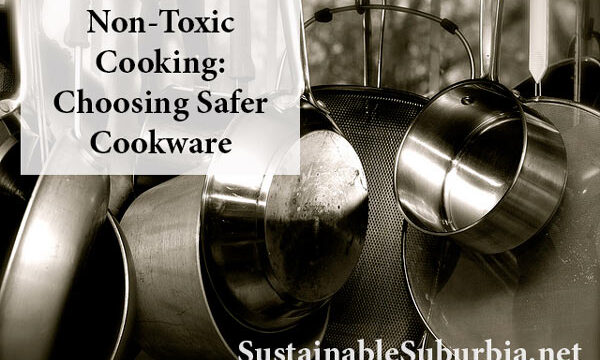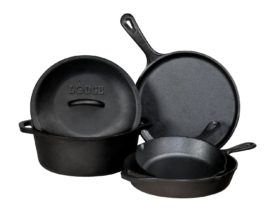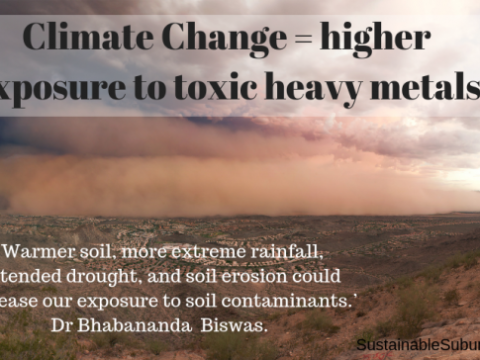Last updated on February 27th, 2024 at 10:32 pm
(Originally published February 2014, Updated 2017, 2019)
Did you know chemicals can leach from your cookware into your food? Not just from plastics in the microwave or from Teflon either. More about that below.
First, safer choices for your cookware:
Stainless Steel – as long as you don’t have a nickel allergy, that is. Avoid cleaning frequently with abrasive materials which may scratch the surface, as chromium and nickel may then be released. Though, if you get “18/0” stainless steal it is nickel free (though therefore no longer truly stainless). See below for details.
Glass (including pyrex) – except for lead crystal of course, which contains lead! Glass is awesome.
Procelain or Ceramic – but watch out for old handmedowns and products not intended for cooking, which may contain lead or cadmium (see below).
Cast iron – is generally thought to be okay, though if you suffer from haemochromatosis or similar conditions you may want to steer clear as it can leach small amount of iron, particularly if it has not built up “a patina of seasoning”.
Edited 2017 to add – Cast Iron is now my favourite choice. We bought this cast iron set when we were travelling in 2014, and aside from the dutch oven (which was too heavy to bring back to Oz) we are still using it daily.
The “patina of seasoning” is now so good I can fry eggs, pancakes etc in it and it is just as non-stick as non-stick pans! Here’s how to PROPERLY season your cast iron.
Ceramic coated cook ware – “The Nutrition Coach” Emma Skourakis chose Silit cookware when replacing some of her old pots and pans, as the safest option. If you’re in the right part of the world you can buy it on Amazon for a reasonable price. If you’re in Australia just do a search on Silit cookware Australia. The original places I found it and linked to no longer appear to sell it, but I found it on lots of other sites – shop around though, prices vary dramatically! [Edited 2017]
Silicone – In most situations, silicone is a good alternative to non-stick baking trays or baking paper (which also contains PFOA – see below). The research is showing that it is generally non-leaching. The exception is with high heats, in the present of fat, and especially for longer periods. In those circumstances some research has found that it can leach siloxanes, which are potentially hazardous.
So I would not use a silicon mat under my lamb roast, or a silicone mold for a meatloaf, but I would definitely recommend it to replace a non-stick baking tray or baking paper, or non-stick muffin cups, with a silicone mat or mold.
We use the Norwex silicon lids as lids (obviously!) over bowls of leftovers, pancake mix (which my 12yo will make, but then leave everyone to cook their own), salads etc. We also use them upside in the oven on a baking sheet, to make it non-stick under biscuits, and other quick bake items (they’re not perfect for this, as they are not perfectly flat – it’s just a clever hack we discovered). (Sadly, these are no longer available for sale, but there are bound to be similar things out there – just look for food-grade silicon from the reputable company.)
Next, what to avoid:
Non-stick cookware
You have probably heard something about non-stick cookware being potentially dangerous, but what does that mean? Teflon – and the same basic coating under many other trade names – is made from a synthetic polymer called polytetrafluoroetheylene (PTFE).
When heated to high heats (and this happens more quickly than you might suppose) , this emits chemicals that can course “Teflon flu”, and can kill a bird in seconds.
Of course, even if you don’t have (noticeable) symptoms, it may be doing longer term damage. According to the Environment Working Group (EWG) “The long-term effects of routine exposure to Teflon fumes, and from Teflon flu itself, have not been adequately studied.”
Perfluorooctanoic acid (PFOA), which is released when Teflon is heated to a high heat, is carcinogenic and has been linked to kidney cancer, testicular cancer, ulcerative colitis, high cholesterol, thyroid disease, and pre-eclampsia.
EWG also recommends that you “Skip the self-cleaning function on your oven”, which may release toxic chemicals from non-stick parts of the oven’s interior.
Also known as “C8”, PFOA is the subject of the 2018 film, The Devil We Know. It is one of the most persistent chemicals in use, completely biodegradable and it accumulates in the blood. Every baby born today, is born with PFOA already inside her. And incidentally, it’s not only in non-stick cookware. It’s also in non-stick baking paper, stain resistant carpet and furniture, water resistant fabrics, dental floss, food wrappers… the list goes on.
Aluminium – anodised or non-anodised.
Aluminium cookware these days is generally anodised to prevent the aluminium leaching, but frequent exposure to acid foods can cause deanodisation.
Aluminium has been linked to brain and bone damage, can interfere with the central nervous system, and has even been linked by some studies to breast cancer. (source)
Copper Cookware
HealthyChild.org also cautions against using coated copper, as the coating can break down over time. Older copperware is likely coated with tin or nickel and should definitely be avoided.
Stainless Steal?
Stainless steel pots and pans are generally a good option, if you are not allergic to nickel, however some people prefer to avoid true stainless steel altogether, to avoid the nickel, which is a heavy metal. HealthyChild.org notes that frequent cleaning with abrasive cleaners can damage the surface and release small amount of nickel and chromium.
How can you tell? If it’s marked
- 18/10 – it’s 18% chromium, 10% nickel
- 18/8 – it’s 18% chromium, 8% nickel
- 18/0 – it’s 18% chromium, no nickel
You can also tell with the magnet test – if it’s 18/0 a magnet will stick to it. Of course, if it’s 18/0 it also won’t be truly stainless. But, on the up side, it will likely be cheaper!
If you do choose stainless steel, go for high quality, which is far less likely to leach nickel. I also recommend cleaning with the non-abrasive but remarkably effective Norwex dishcloth, with is a knitted nylon net, and won’t damage the surface.
Older ceramics or those not intended for cooking
These may contain lead or cadmium in high levels. There are home test kits you can use, but they may not pick up low levels of these contaminants, which can still be dangerous. This also applies to older enamel on cast iron, as the enamel used to contain lead. (source) Also be cautious of ceramics bought in another country, which may have different standards.
Do you have a favourite cookware choice? Is it safe?
__________
Image by Ryan Detzel





You know this is something I had truly never thought about! Now I’m gonna have to go through my cupboards and check everything! Thanks for sharing. #teamIBOT
You’re welcome!
Oh man!!! Now how am I going to cook pancakes? I love my non-stick pans!!!
I know
Hi,
Thanks for the post. I have been wondering about the safety of Aluminized Steel? Apparently the aluminum is oxidized and I was told it was no longer reactive, however I have been unable to find any evidence regarding this.
I hope you can help me out with this question.
Thanks
Hi B,
I am doing some research, and will get back to you!
Sad that you never got back about aluminized steel.
Sorry Bron! I didn’t find anything conclusive either and forgot to get back to you. The claim is that the process it has gone through makes it inert (aluminium and silicon mixed) but I haven’t found any research testing it.
Kirsten,
My heavy iron ceramic coated pot is the one that we use the most. We call it our ‘magic pot’. I love it.
That sounds great Tania!
Oh ths is a bit scary – I love my non stick pan! It’s what the “experts” tell you to use when trying to lose weight to cut down on oils/butter etc.
I know.
I have non-teflon semi-non-stick pans, but it turns out they still have the PTFE – but, is it as bad? I still need to do more research, as there is a lot of conflicting information out there. Limiting my use for now
I’m pretty well using my – now well seasoned – cast iron in place of non-stick now. It works pretty well
I’ve been looking for a new pan. I will have to check this one out!
I’m also wondering about aluminized stainless steel. Logic dictates it shouldn’t be any better than straight aluminum. Is it as bad?
The claim is that the process it has gone through makes it inert (aluminium and silicon mixed) but I haven’t found any research testing it.
If informative article. I think stainless steel cookware is the safest among all above despite a little bit pricey.